check engine light AUDI S8 2011 User Guide
[x] Cancel search | Manufacturer: AUDI, Model Year: 2011, Model line: S8, Model: AUDI S8 2011Pages: 302, PDF Size: 76.07 MB
Page 194 of 302
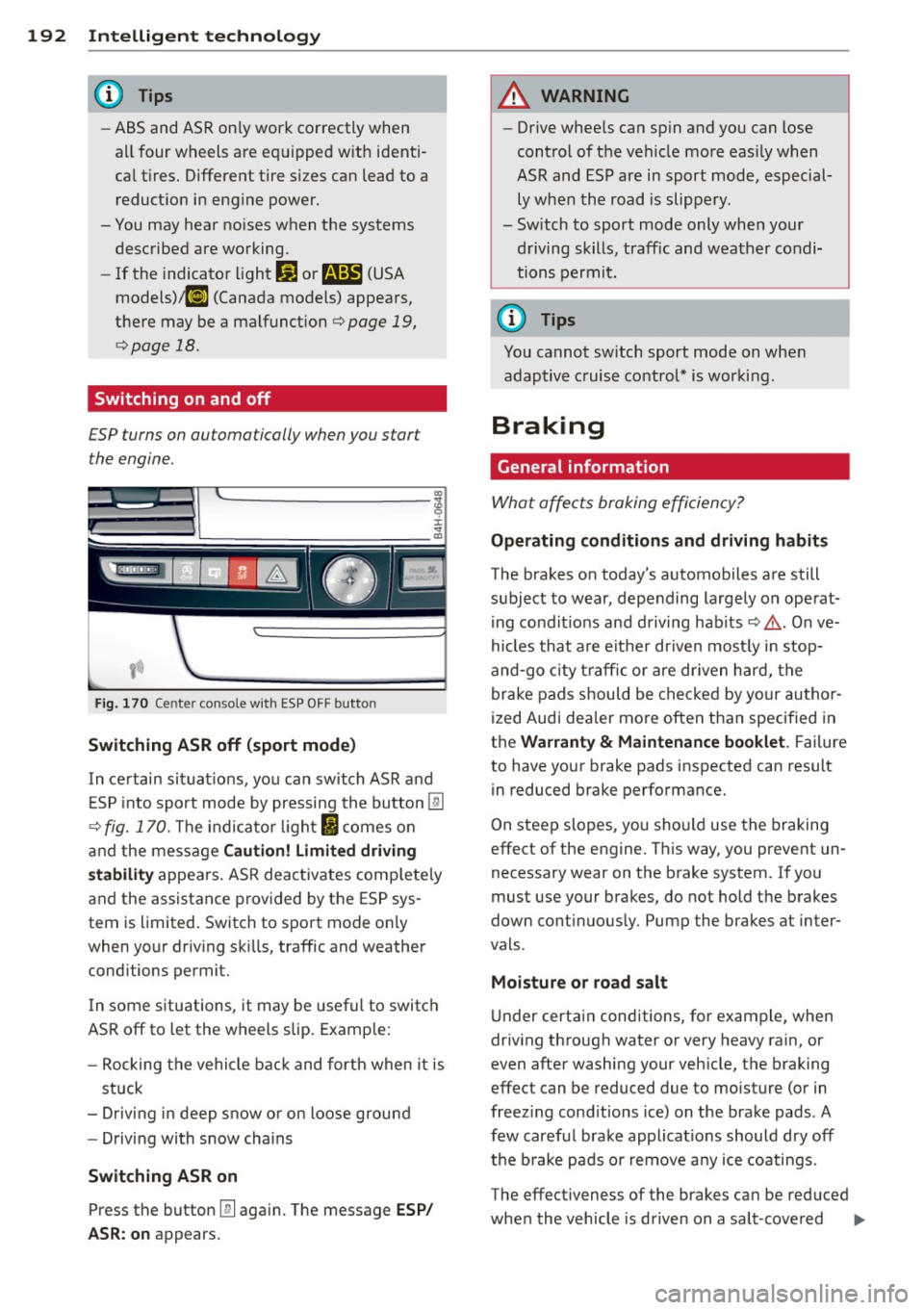
192 Intelligent technology
-ABS and ASR on ly work correctly when
a ll four wh eels are eq uipped w ith ident i
ca l tires. Different tire s iz es can lead to a
reduct ion in engine power.
- You may hear no ises when the systems
described are working.
- If the indicator light
DJ or m (USA
models) ;tl] (Canada models) appea rs,
there may be a malfunct ion
c::;, page 19,
c::;, page
18 .
Switching on and off
ESP turns on au toma tically when you s tar t
the engine .
Fig . 170 Cen ter con sole w it h ESP OF F button
Switching ASR off (sport mode)
In ce rtain situat io ns, yo u can switch ASR and
E SP into sport mode by pressing the button
l!I
c::;, fig. 170. The indicato r light fl comes on
and the mess age
C aution! Limit ed driving
s tability
appears . ASR deact ivates comp lete ly
and the assistance prov ided by the ESP sys
tem is limited. Switch to sport mod e onl y
when your d riv ing sk ills, traffic and weather
conditions permit.
In some situations, it may be useful to switc h
ASR off to let the wh eels slip. Example:
- Rocking the vehicle bac k and forth when it is
stuck
- Driv ing in deep snow or on loose ground
- Driving with snow cha ins
Sw itching ASR on
Press the button I!] aga in. The message ESP /
ASR: on appears .
A WARNING
-Drive whee ls can sp in and you can lose
control of the vehicle more eas ily when
ASR and ESP are in sport mode, especial
ly whe n the road is slippery .
- Sw itch to sport mode only when your
d riving skills, traff ic and weather condi
tions perm it.
@ Tips
You cannot sw itch sport mode on whe n
adaptive c ruise co ntrol* is worki ng.
Braking
General information
Wha t affe cts braking effi cien cy?
-
Operating conditions and driving habits
The brakes o n today's automobiles are still
s u bjec t to wear, depending largely on operat
ing cond it ions and driving hab its
c::;, &. . On ve
hicles that a re e it h er dr iven most ly in stop
and-go city t ra ffi c or are dr iven hard, the
brake pads should be checked by yo ur au thor
ized Audi dea ler mo re often than specified in
t h e
Warranty & Maintenance booklet. Failure
to have your brake pads inspected can result in reduced brake performance.
On steep slopes , you sho uld use the braking
effect of the engine. This way, you prevent un
necessary wear on the brake system . If you
must use your b rakes, do not hold t he brakes
down continuous ly. Pump the brakes at in ter
vals .
Moisture or road salt
U nd er certain conditions, for example, when
driving through water or very heavy rain, or
even after washing your veh icle, the braking
effect can be reduced due to moisture (or in
freez ing cond itions ice) on the brake pads . A
few caref ul brake applicat ions should dry off
t h e b rake pads or remove a ny ice coatings .
The effectiveness of the brakes ca n be reduced
when the vehicle is d riven on a sa lt-covered
ll>
Page 201 of 302
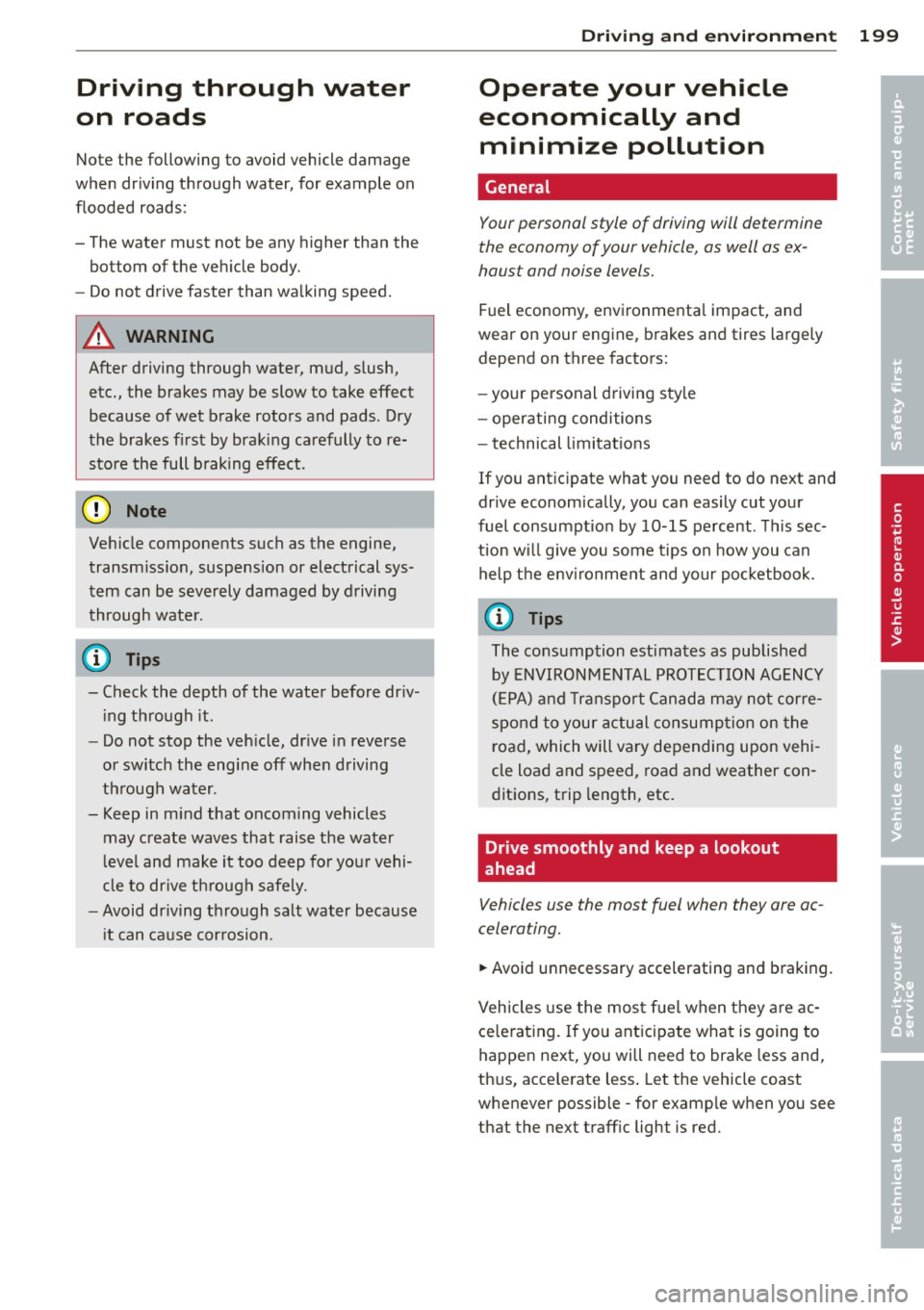
Driving through water
on roads
Note the following to avoid vehicle damage
when driving through water, for example on
flooded roads:
- The water must not be any higher than the
bottom of the vehicle body.
- Do not drive faster than wa lking speed.
A WARNING
After driving through water, mud, slush,
etc., the brakes may be slow to take effect
because of wet brake rotors and pads. Dry
the brakes first by braking carefully to re
store the full b raking effect.
([) Note
Vehicle components such as the engine,
transmiss ion, suspension or electrical sys
tem can be severely damaged by driving
through water.
- Check the depth of the water before dr iv
i ng through it.
- Do not stop the veh icle, drive in reverse
or switch the engine off when driving
through water .
- Keep in mind that oncoming vehicles
may create waves that raise the water
level and make it too deep for your vehi
cle to drive th rough safely.
- Avoid dr iving through sa lt water because
i t can cause corrosion.
Dri vin g and en vironm ent 199
Operate your vehicle
economically and
minimize pollution
General
Your personal style of driving will determine
the economy of your vehicle, as well as ex
haust and noise levels.
Fuel economy, environmenta l impact, and
wear on your eng ine, brakes and tires largely
depend on three factors:
- your personal d riving style
- operating conditions
- technical limitat ions
If you ant ic ipate what you need to do next and
drive economically, you can easily cut your
fuel consumpt ion by 10-15 percent . This sec
tion w ill give you some tips on how you can
help the environment and your pocketbook.
@ Tips
The consumption estimates as published by ENVIRONMENTAL PROTEC TION AGENCY
( E PA) and Tra nspo rt Canada may not corre
spond to your actual consump tion on the
road, which will vary depending upon vehi
cle load and speed, road and weather con
ditions, trip length, etc.
Drive smoothly and keep a lookout
ahead
Vehicles use the most fuel when they are ac
celerating.
.,. Avoid unnecessary accelerating and braking.
Vehicles use the most f uel when they are ac
ce le rating. If you ant icipate what is going to
happen next, you will need to brake less and,
thus, acce lerate less . Let the vehicle coast
whenever possible - for examp le when you see
that the next traff ic light is red.
•
•
Page 202 of 302

200 Driving and en vi ro nm ent
Avoid full throttle
Driving at moderate speeds saves fuel and
improves your mileage .
"'Try and keep well below your car 's maximum
speed.
Accelerating gently reduces fuel consump
tion, engine wear, and does not disturb the
environment. F ue l consumption, exhaust em issions and en
gine noise increase disproportionately at high
speeds. If you drive at approximately three
quarters of top speed, fue l consumption will
be reduced by one half. Never drive faster
than the posted speed limit and weather con
d itions permit .
Reducing unnecessary idling
Even when your car is just idling it burns up
fuel.
"'Shut the engine off when you are not driving
the vehicle .
"'Do not warm up the veh icle by letting the
engine run at idle .
It makes sense to shut
off the e ngine in traff ic
jams, when waiting for trains to pass at ra il
road crossings , or at traff ic lights that have
long wa its on red. Turning the engine
off fo r
just
30-40 seconds saves more fue l than is
burned s tarting the eng ine again .
It takes a long time for the engine to warm up
fully when it is running at idle . Howeve r, wear
and noxious em issions are especially high
when the engine is warming up. So you should
drive away as soon as you start the engine and
avoid running at high rpms while the engine is
still warming up .
([) Note
Do not leave engine idling unattended af
ter starting . If warning lights should come
on to indicate improper operation, they
wou ld go unheeded. Extended idling also
produces heat, which cou ld result in over- heating or other damage to the vehicle or
other property .
Regular maintenance
A badly tuned engine unnecessarily wastes a
lot of fuel.
"' Have your ve hicle serviced at reg ular inter -
vals.
By having your veh icle regu larly serviced by an
Audi dealer he lps to ensure that it runs p rop
erly and economically. The condition of your
vehicle not only affects its sa fety and ability to
hold its value, it also affects
fuel c onsump
tion .
Check your oil e ach time you fill your t ank .
The amount of oil used is related to engine
load and speed .
It is normal for the oil consumption of a new
engine to reach its lowest value after a certa in
mileage has been driven.
You must drive your veh icle about 3,000 m iles
(5,000 kilometers) before you can properly
assess oil consumpt ion.
This also app lies to fue l consumption and en
gine output.
(D Note
- Have your vehicle maintained proper ly
and in accordance with the service rec
ommendations in your Warranty
& Main
tenance booklet. Lack of proper ma inte
nance as well as improper use of the ve
hicle will impair the function of the
em iss ion contro l system and cou ld lead
to damage.
- Do not alter or remove any component of
the Emission Control Sys tem unless ap
proved by the manufacture r.
- Do not alte r or remove any device, such
as heat sh ie lds, switches, ign it ion w ires,
valves, which are designed to protec t
your vehicle's Emission Control System
and other impo rtant vehicle compo
nents .
Page 205 of 302
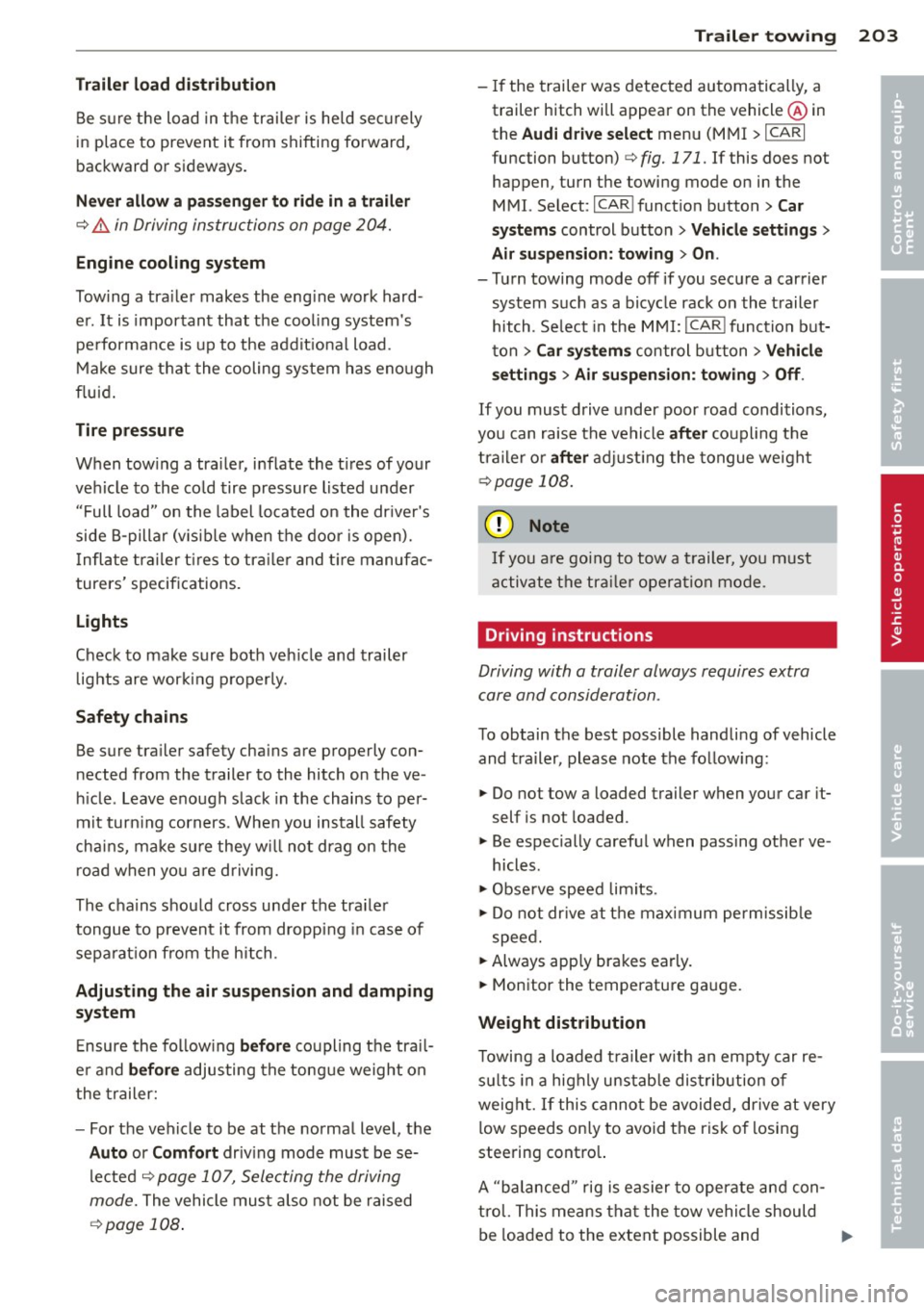
Trailer lo ad di stri bu tion
Be s ure the load in the trai ler is held securely
in place to prevent it from shifting forward,
backward or sideways.
N eve r allow a p assenger to rid e in a tr ailer
,=:, .&. in Driving instructions on page 204.
Engine cooling s ystem
Towing a tra iler makes the eng ine work hard
er . It is important that the cooling system's
pe rformance is up to the addit ional load .
Make sure that the cooling system has enough
fluid.
Tire p res sure
When tow ing a trailer, inflate the t ires of your
vehicle to the co ld tire pressure listed under
" Full load " on the label located on the dr iver's
side B-pillar (v is ible when the door is open).
I nflate trailer tires to tra iler and t ire manufac
turers' specifications.
Lights
Check to make sure both veh icle and trailer
lights are working properly .
Safety chain s
Be sure trailer safety cha ins are properly con
nected from the trailer to the hitch on the ve
h icle . Leave enough slack in the chains to per
mit turn ing corners . When you install safety
cha ins, make sure they w ill not drag on the
r oad when yo u are driving.
The chains should cross under the trailer
tongue to prevent it from dropping in case of
sepa rat ion from the hitch .
Adjusting the air su spens ion an d damping
s y stem
Ensure the follow ing b efore coupling the trai l
e r and
b efo re adjusting the tongue weight on
the trailer:
- For the veh icle to be at the normal level, the
A uto or Comfort driv ing mode must be se
lected
,=:, page 10 7, Selecting the driving
mode. The vehicle must a lso not be raised
,=:, page 108 .
Trailer to win g 203
-If the trailer was detected automatically, a
trailer hitch wi ll appear on the veh icl e@ in
the
Aud i dr ive se lect menu (MMI > ICARI
function button)
,=:, fig. 171. If this does no t
happen , turn the towing mode on in the
MMI. Select: I CAR I funct ion button>
C ar
sys tem s
control button > Vehicle setting s >
Air su sp en sion: t owing > O n.
- Turn towing mode off if you secure a carrier
system such as a bicycle rack on the trailer
hitch. Se lect in the M MI: ICAR !function but
ton >
Car syste m s control button > Vehi cle
se tting s
> Air su spen sion : towin g > Off.
If you must drive under poor road conditions,
you can raise the vehicle
aft er coupling the
tra iler or
aft er adjust ing the tongue we ight
,=:, page 108.
(D Note
If you a re going to tow a t railer, you must
activate the tra iler operation mode .
Driving instructions
Driving with a trailer always requires extra
care and consideration .
To obtain the best possible handling of vehicle and trailer, please note the follow ing :
.,. Do not tow a loaded trailer when your car it
self is no t loaded.
.,. Be especially careful when passing other ve
hicles .
.,. Obse rve speed limits .
.,. Do not dr ive at the max imum permissib le
speed.
.,. Always app ly brakes early .
.,. Monitor the temperature gauge.
Weight distribution
Towing a loaded t railer with an empty car re
s ul ts in a highly unstable distribution of
weight. If this cannot be avoided, dr ive at very
low speeds on ly to avoid the risk of losing
steering contro l.
A "balanced " rig is easier to operate and con
trol. This means tha t the tow vehicle should
be loaded to the extent possible and
IJI>
•
•
Page 218 of 302

216 Cleaning and protecti on
- To avoid damage, have stubborn stains
removed by a commercial cleaning spe
cialist.
- Do not use br ushes, stiff sponges or sim
ilarly abrasive cleaning aids.
Safety belts
Only well-maintained safety belts work relia
bly when needed .
> Keep belts clean.
> For cleaning, use a mild soap and wate r sol
ution . Let be lts dry thoroughly and away
from direct sunlight .
> Do not allow inertia reel safety be lts to re
tract before they are completely dry.
> Check the condition of your safety belts reg
ularly .
Heavily soiled safety belts may not retract
properly.
.&_ WARNING
Damaged safety belts can break in a crash.
- Anything that might damage your safety
belts could mean that you and your pas
sengers would not be adequately pro
tected in an acc ident.
- Safety belt performance depends on cor
rect installation. Never remove belts
from the vehicle to clean them.
- Do not use chemical cleani ng agents,
bleach or dyes. They have corrosive prop
ert ies which weaken the webbi ng.
- When cleani ng your safety belts, inspect
them for damage.
If you discove r dam
age, see you r A udi dealer.
- Always read and heed all WARNI NGS and
other information
c:> page 206.
Cooler
A ppl ies to vehicles: with cooler
A layer of ice or frost in the cooler interferes
with its cooling performance .
Clean ing
The refr igerator sho uld be cleaned reg ularly.
> Wash the coo ler with lukewarm wate r and a
mild cleaning solution, if necessary.
> Then wipe the cooler dry.
> Dust and d irt will accumulate near the venti
lation openings in the luggage compart
ment due to normal cooler usage. This
should be cleaned regularly.
D ef rosting
> Switch the coo ler off c:> page 72.
> Remove any food or beverages and allow the
coo ler to defrost with the door open.
> W ipe the inside of the cooler dry and clea n
the cooler, if necessary .
Defrost the cooler if you will not be us ing it
for extended periods of time .
(D Note
- Do not try to speed up the defrosting
process by apply ing heat.
- To reduce the risk of persona l injury or
damage to the refr igerator,
- do not use any abrasive cleaners, sol
vents, wax, agg ress ive clean ing solu
tions, solut io ns w it h strong frag rances,
etc.,
- d o no t clean the co oler w ith cleaning
tools su ch as s teel woo l.
Engine compartment
Be especially careful when cleaning the en
gine comportment.
Alway s switch off the ignit ion b efor e cle an
ing the engine
c:> ,&. .
Plenum panel
Remove leaves from the plenum panel in front
of the w indshield under the eng ine compart
ment . This prevents the wate r drain holes
from becom ing b locked, and it preve nts de
br is from entering the vehicle inte rior through
the heat ing and ven tilat ion duc ts.
Corrosion protection
The eng ine compartment and transmission
have been corrosion-protected at the factory .
ll-
Page 224 of 302
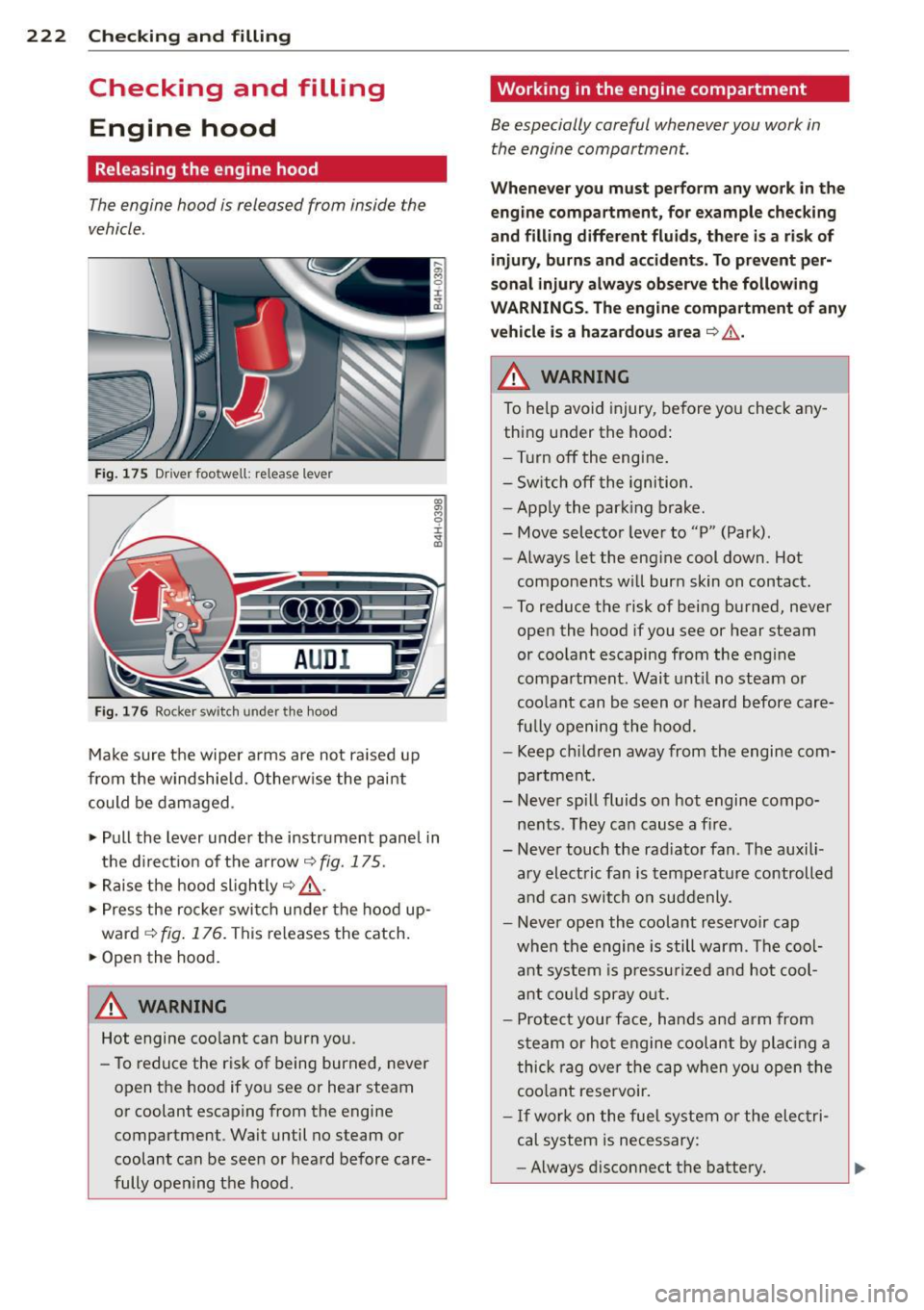
222 Checking and filling
Checking and filling Engine hood
Releasing the engine hood
The engine hood is released from inside the
vehicle .
Fig. 175 Driver foo twell: release lever
AUD I
Fig. 176 Rocker switch un der the hood
Make sure the wiper arms are not raised up
from the windshield. Otherwise the paint
could be damaged.
.,. Pull the lever under the instrument panel in
the direction of the arrow
¢ fig. 175.
.,. Raise the hood slightly¢,&. .
... Press the rocker switch under the hood up
ward ~
fig. 176. This releases the catch.
... Open the hood.
&_ WARNING
Hot engine coolant can burn you.
- To reduce the risk of being burned, never
open the hood if you see or hear steam
or coolant escaping from the engine compartment . Wait until no steam or
coolant can be seen or heard before care
fully opening the hood .
' Working in the engine compartment
Be especially careful whenever you work in
the engine compartment.
Whenever you must perform any work in the
engine compartment, for example checking
and filling different fluids, there is a risk of injury, burns and accidents. To prevent per
sonal injury always observe the following
WARNINGS. The engine compartment of any
vehicle is a hazardous area
¢ ,&. .
/n.. WARNING
To help avoid injury, before you check any
thing under the hood:
- Turn off the engine.
- Switch off the ignition .
- Apply the parking brake.
- Move selector lever to "P" (Park) .
- Always let the engine cool down. Hot
components will burn skin on contact.
- To reduce the risk of being burned, never
open the hood if you see or hear steam
or coolant escaping from the engine
compartment. Wait until no steam or
coolant can be seen or heard before care
fully opening the hood.
- Keep children away from the engine com
partment.
- Never spill fluids on hot engine compo
nents . They can cause a fire .
- Never touch the radiator fan. The auxili
ary electric fan is temperature controlled
and can switch on suddenly .
- Never open the coolant reservoir cap
when the engine is still warm . The cool
ant system is pressurized and hot cool
ant could spray out.
- Protect your face, hands and arm from
steam or hot engine coolant by placing a
thick rag over the cap when you open the
coolant reservoir.
- If work on the fuel system or the electri
cal system is necessary:
- Always disconnect the battery.
Page 226 of 302
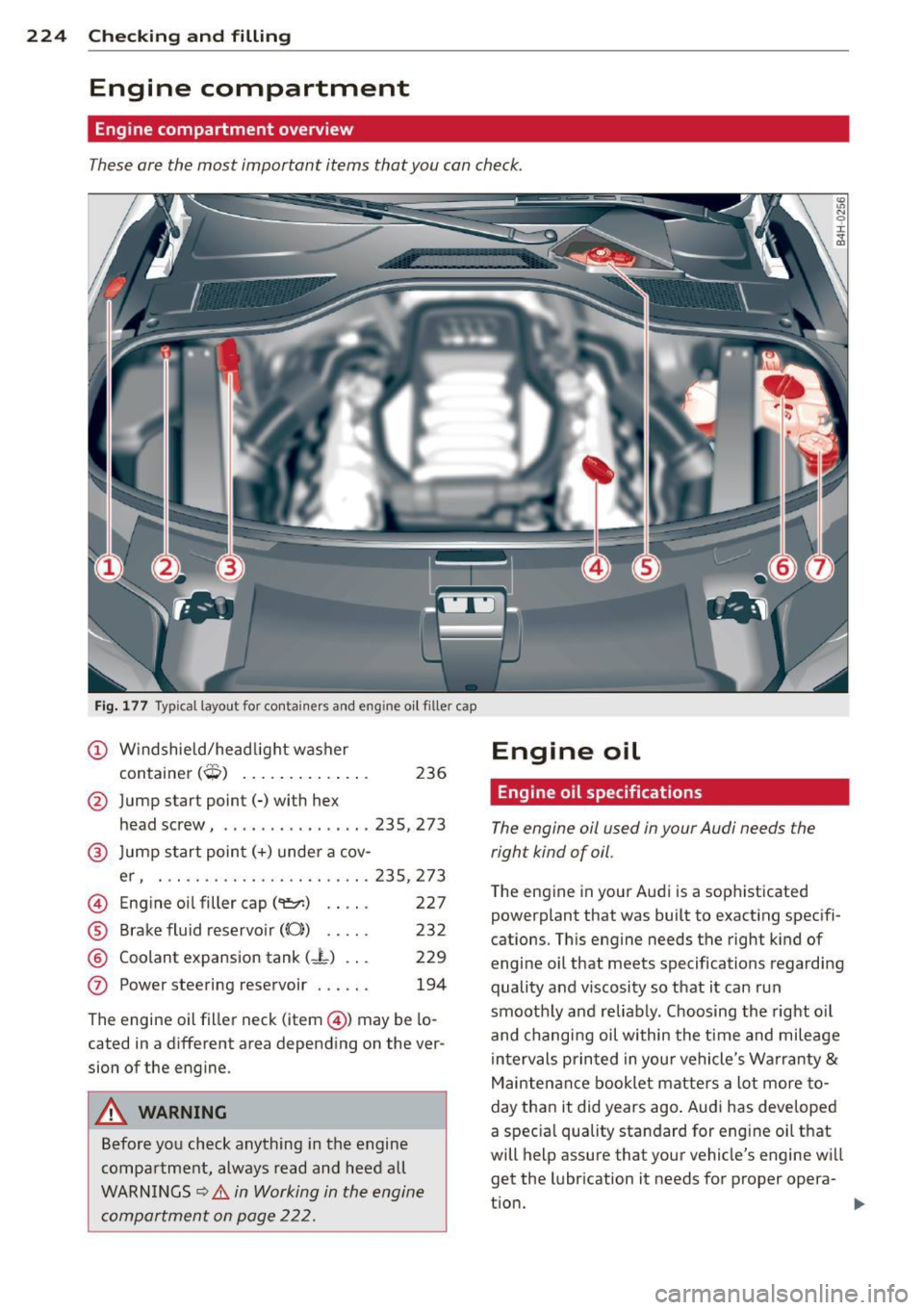
224 Checking and filling
Engine compartment
Engine compartment overview
These are the most important items that you can check.
Fig . 177 Typ ical layout for conta iners a nd eng ine o il filler cap
(D W indshield/head light washer
t . (?::..) con
amer ~ .... ... . ... .. . 236
@ Jump start point(-) with hex
h ead screw, ................
235, 273
@ Jump start point(+) unde r a cov-
e r, . ...... .... ......... .. .
23 5, 273
© Eng ine oi l filler cap ('t::r.) . . . . . 227
® B rak e fluid reservo ir ((0)) . . . . . 232
® Coolant expansion tank (J-) . . . 229
0 Power steering reservoir . . . . . . 194
The engine oil filler neck (item@) may be lo
cated in a d ifferent area depending on the ver
sion of the engine .
A WARNING
Before you check anything in the engine
compartment, always read and heed all
WAR NINGS¢
A in Working in the engine
compartment on page 222.
Engine oil
Engine oil specifications
The engine oil used in your Audi needs the
right kind of oil.
T he eng ine in your Audi is a sophisticated
powerplant that was built to exacting specifi
cations . Th is engine needs the right k ind of
engine oil that meets specifications regarding
quality and v iscosity so that it can run
smoothly and reliab ly . Choosing th e right o il
and changi ng oil within the t ime and mileage
in tervals prin ted in you r vehicle's Warr anty
&
Maintenan ce booklet matte rs a lot more to
day tha n it did years ago . Audi has develope d
a spec ia l quality standard for engine oil that
will help assure that you r vehicle's engine w ill
get the lubr ication it needs for proper opera-
t ion. ..,.
Page 228 of 302
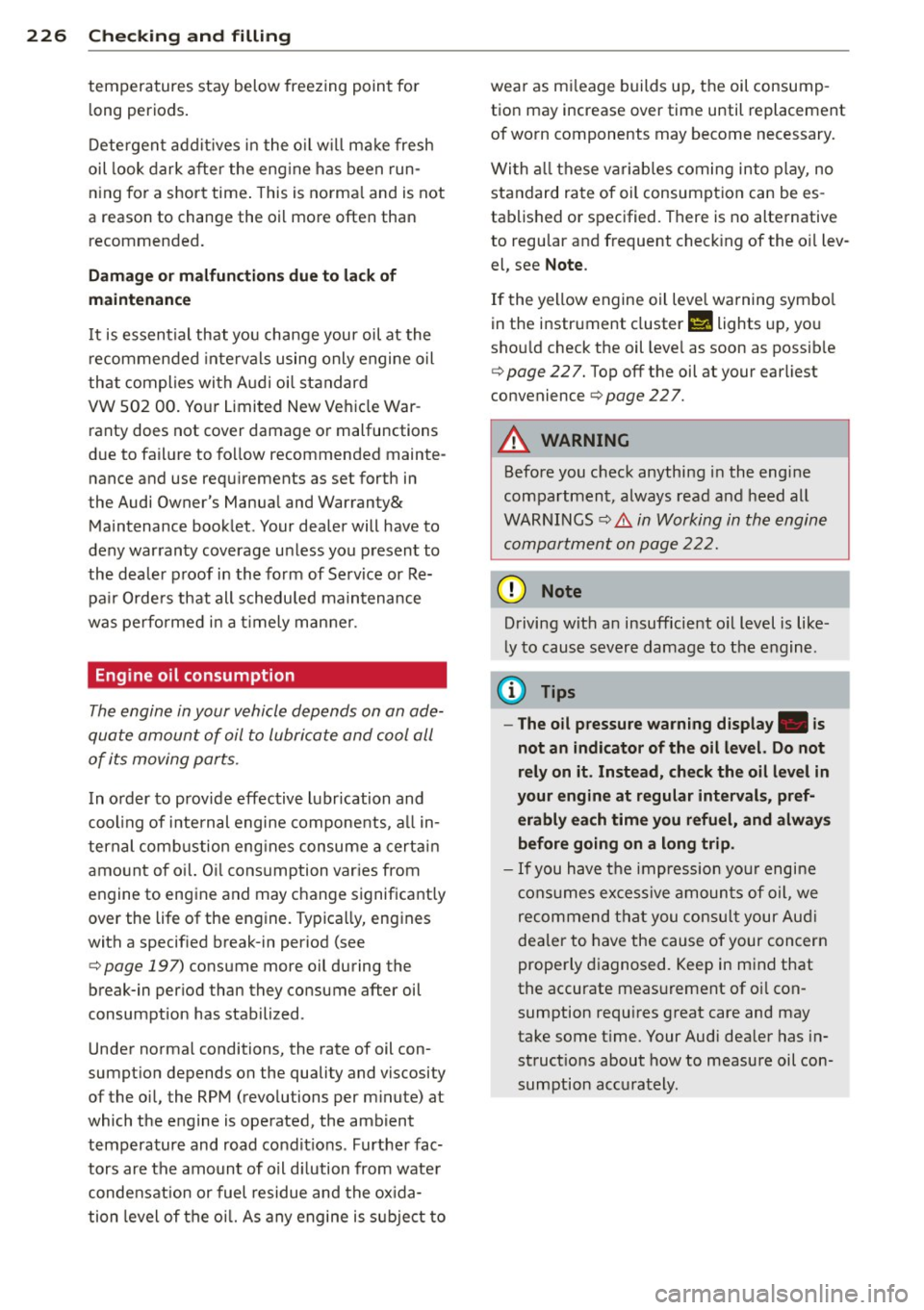
226 Check ing and filling
temperatures stay below freezing point for
long periods.
Detergent add it ives in the o il w il l make fresh
oil look dark after the eng ine has been run
ning for a short time . This is norma l and is not
a reason to change the oi l more often than
recommended.
Dam age or ma lf u ncti ons du e to lack of
m ainten ance
It
is essential that you change your oil at the
recommended in tervals using only engine o il
that complies with Audi oi l standard
VW 502 00. You r Limited New Vehicle War
ranty does not cover damage or malfunctions
due to fail ure to fo llow recommended mainte
nance and use requ irements as set forth in
the Audi Owner's Manual and Warranty&
Maintenance book let . Your dealer will have to
deny warranty coverage unless you present to
the dea ler proof in the form of Service or Re
pa ir Orders that all scheduled maintenance
was performed in a t imely manner.
Eng ine oil consumption
The engine in your vehicle depends on an ade
quate amount of oil to lubricate and cool all
of its moving parts.
In order to provide effective lubrication and
cool ing of internal engine components, a ll in
ternal comb ustion eng ines consume a certa in
amount of oil. O il consumption varies from
engine to engine and may change significantly
over the life of the engine. Typica lly, engines
with a specif ied break-in period (see
¢
page 197) consume more oil during the
break-in period than they consume after oil
consumption has stabilized.
Under norma l conditions, the rate of oil con
sumpt ion depends on the quality and viscosity
of the oil, the RPM (revolutions per m inute) at
which the engine is operated, the ambient
temperature and road condit ions . Further fac
tors are the amount of oil d ilution from water
condensat ion or fuel residue and the ox ida
tion level of the oi l. As any engine is subject to wear as mi
leage builds up, the oil consump
tion may increase over time until replacement
of worn components may become necessary.
With a ll these variab les coming into play, no
standard rate of oil consumption can be es
tablished or specified. There is no alternative
to regu lar and frequent check ing of the o il lev
el, see
Note .
If
the yellow engine oil leve l warning symbo l
in the instrument cluster
m lights up, yo u
shou ld check the oil leve l as soon as possib le
¢
page 22 7. Top off the oil at your earliest
convenience ¢
page 22 7.
A WARNING '"---
Before you check anything in the engine
compartment, always read and heed all
WARNINGS¢
A in Working in the engine
comportment on page 222.
(D Note
Driving w ith an insufficient o il level is like
ly to cause severe damage to the engine .
(D Tips
-The oil pressu re warn ing display. is
not an indicator of the oil le vel. Do not
r el y on it . In ste ad, ch eck the oil lev el in
y our engin e at regular inter vals , pref
erably ea ch time you r efu el, and alway s
before going on a long trip .
-If you have t he impression yo ur engine
cons umes ex cessive amoun ts of o il, we
recommend that you consu lt your Aud i
dea ler to have the cause of your concern
properly diagnosed. Keep in mind that
the accurate meas urement of oi l con
sumption requ ires great care and may
take some t ime. Your Audi dea ler has in
structions about how to measure oil con
sumption accurately.
-
Page 232 of 302

230 Check ing and filling
th e "min" and "max" markings. When the
engine is wa rm, the level may be slightly
above the "max" marking.
The location of the coolant expansion tank
can be seen in the engine compartment ill us
tration ¢
page 224 .
To obtain an accurate read ing , the engine
must be switched
off .
The expans io n tank in you r vehicle is equipped
with an e lectric coolant level se nsor.
When the coolant level is too low, the warning light in the A uto-Check System ¢
page 15 will
i llum inate u nti l you add coolant and the level
has been restored to normal. Even though
there is an electric coolant level sensor , we
still recommend you check the coolant leve l
from time to time.
Coolant loss
Coolant loss may indicate a leak in the cooling
system. In the event of coolan t loss, the cool
ing system should be inspected immedia tely
by your authorized Audi dealer. It is not
enough mere ly to add coolant.
I n a
se aled system, losses can occur only if
the boiling point of the coolant is exceeded as
a result of overheat ing.
A WARNING
T he cooling system is unde r pressure and
can get ve ry hot . Reduce the risk of sca ld
ing from hot coolant by following these
steps.
- Turn off the engine and allow it to cool
down.
- Protect yo ur face, hands and arms from
escaping fluid and steam by cove ring the
cap with a large, thick rag.
- Turn the cap slowly and very carefu lly in
a counter-clockwise direction wh ile ap
plying light, downward pressure on the
top of the cap .
- To avoid being b urned, do not spill ant i
freeze or coolant on the exhaust system or hot eng ine parts . Under ce rtai n condi -
'
tions, the ethylene glycol in engine coo l
ant can catch fire.
@ Note
Do not add any type o f radiato r leak sea l
ant to your vehicle's engine coolant. Add
i ng radiator repa ir fluid may adverse ly af
fect the funct ion and performance of your
cooling system and could result in damage not covered by your New Veh icle L imited
Warranty .
Adding coolant
Be very careful when adding engine coolant.
Before you check anyth ing in the engine com
partment,
always read and heed all WARN
INGS
c> .&. in Working in the engine compart
ment on page
222 .
• Turnoff the engine .
• Let the eng ine cool down.
• Place a thick rag over the coolant expansion
tank
c> page 22 9, fig . 180 and carefully
tw ist t he cap co unter-clockwise c> ,& .
• Add coo lant .
• Twist the cap o n again
tightly.
Replacement engine coo lant must conform to
exact spec ificat ions ¢
page 229, Coolant .
Even in a n emerge ncy, if coo la nt addi-
t ive G 12++ , G12+ or G12 is not ava ilable , do
not use a d iffe ren t addit ive. Use plain water
instead unt il you can get the cor rect add itive
and can restore the correct ratio . This sho uld
be don e as soon as possible.
If you have los t a consider able amount o f
coolant, then you sho uld add cold ant ifreeze
and cold wate r on ly when the engine is cold.
Always use
new engine coo lant when refilling.
Do not f ill coolant above the "MAX" mark. Ex
cess coola nt w ill be fo rced o ut through the
pressure relief valve in t he cap when the e n-
gine becomes ho t.
Ill>
Page 233 of 302

A WARNING
-=
-The cooling system is under pressure and
can get very hot . Reduce the risk of
scald ing from hot coolant by following
these steps .
- Turn
off the engine and a llow it to cool
down.
- Protect your face, hands and arms from
escaping fluid and steam by covering
the cap with a large, thick rag.
- Turn the cap slowly and very carefully in a counter-clockwise direction while
applying light, downward pressure on
the top of the cap.
- To avoid being burned, do not spi ll an
tifreeze or coolant on the exhaust sys
tem or hot engine parts. Under certa in
conditions, the ethylene glycol in en
g ine coolant can catch fire.
- Antifreeze is poisonous. Always store an
t ifreeze in its original container and well
out of the reach of children.
- If you drain the coolant, it must be
caught and safely stored in a proper con
tainer clearly marked "poison".
(D Note
- Coolant pollutes the env ironment and
could cause an engine fire. Excess cool
ant w ill be forced out through the pres
sure relief valve in the cap when the en
gine becomes hot.
- If, in an emergency, only water can be
added, the correct ratio between water
and antifreeze
Q page 229 must be re
stored as soon as possible.
@ For the sake of the environment
Drained coolant should not be reused. Al
ways dispose of used coolant while obse rv
ing all environmental regulations.
Checkin g and fillin g
Radiator fan
The radiator fan switches on automatically by
itself .
The rad iator fan is dr iven by the engine via the
V-belt. The viscous clutch regulates the speed
of the fan according to the temperature of the
coolant .
An auxiliary electric radiator fan* switches on
and
off depending on coolant temperature
and other vehicle operat ing cond it ions .
After you switch the engine
off, the aux iliary
fan can continue running for up to 10 minutes - even with the ignition
off. It can even switch
on again later by itself
Q &., if
- the temperature of the engine coo lant rises
due to the heat build-up from the engine in
the engine compartment, or
- the engine compartment heats up because the vehicle is parked in intense sunlight.
A WARNING
- To reduce the risk of personal in jury nev
er touch the radiator fan .
- The auxiliary electric fan is temperature
controlled and can switch on suddenly
even when the engine is not running.
- The auxiliary radiator fan sw itches on au
tomatically when the engine coolant reaches a certa in temperature and w ill
continue to ru n until the coolant temper
ature drops.
231
•
•